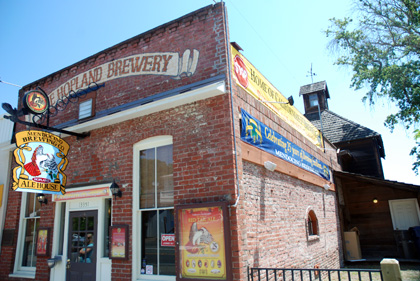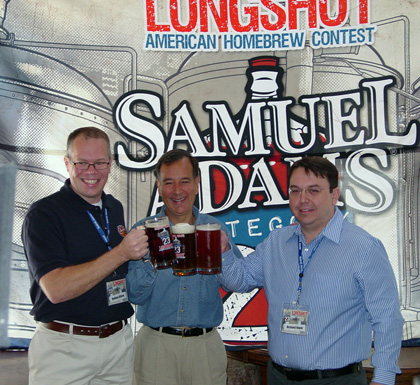
NPR’s Science Friday had a show last week devoted to The Science of Smell. If you’ve ever taken tasting beer seriously, you know how important smell is to the flavor of beer (and everything else). Host Ira Flatow discussed Olfaction with research scientists Stuart Firestein and Donald Wilson. The show’s only a little under 18 minutes but is pretty interesting.
For example, twenty years ago [the field of olfaction] made the most important discovery in the modern era of olfaction, which “was the identification and cloning of a large family of receptors in our noses that mediate the sense of smell that act like a lock. If you think of it, odor is a key, and when they fit together, the brain is clued in to the fact that this odor is out there somehow. And this identification of this large, large family of genes, a thousand of them in many animals, as many as 450 in us, mediates this smell.
This turns out to be “the largest gene family in the mammalian genome. The mammalian genome, typically, we think consists of about 25,000 genes. So in a mouse, it’s about 5 percent of the genes and even in us, it’s almost 2 percent. About one out of every 50 genes in your genome was devoted to your nose.”
And here’s a later revealing exchange, from the transcript:
Dr. FIRESTEIN: I think we use our nose a lot more than most people believe. The biggest problem with our sense of smell or the feeling that we don’t have a good sense of smell is actually our bipedalism, the fact that we walk on two legs. And we have our noses stuck up here five or six feet in the air, when all the good odors are about eight or 10 inches off the ground. Or for example, as the case with other animals, they’re more willing to put their nose where the odors are, shall we say, delicately.
FLATOW: And well, we’ve always heard that animals like let’s pick out dogs, bloodhounds and things like that, that dogs are able to smell so much more sensitively than us in all different kinds of smells. Is that true?
Dr. FIRESTEIN: Well, it’s a good question. I mean, I often say to people who ask me that question, if they have such a good sense of smell, why do they think they do that greeting thing that they do?
Dr. FIRESTEIN: You think you could do that from 10 feet away, you know?
FLATOW: Well, that’s true. They get right up there and sniff you.
Dr. FIRESTEIN: Boy, they sure do.
FLATOW: So why do they need to be so close if they smell…
Dr. FIRESTEIN: Yes, well so some of this is behavioral, and a part of it, the another way to show that, I think, for humans, is that we actually have very sophisticated palate, for example, for food, much more than many other animals and we know that most of flavor is really olfaction.
And here’s another interesting exchange about the specifics of our sense of smell, insert “beer” in the place of “coffee” and the process of judging beer critically works the same way.
FLATOW: Don Wilson, tell us what happens what is connected to our noses in the sensory? What goes on in the brain when we smell something?
Dr. WILSON: Well, it’s actually really exciting because – so these you mentioned the ABCs of olfaction. I think that’s a good analogy because these hundreds of different receptors that Stuart just mentioned essentially are recognizing different features of a molecule. You don’t have — for most of odors, you don’t have a receptor for that particular odor. You don’t have a coffee receptor or a vanilla or a strawberry receptor. You have receptors that are recognizing small pieces of the molecules that you’re inhaling, and the aroma of coffee, for example, is made up of hundreds of different molecules.
So what the brain then has to do is make sense of this pattern of input that’s coming in: I’ve got receptors A, B and C activated when I smell this odor, and I’ve got receptors B, C, D and E activated when I smell this other odor. And what we’ve found is that what the brain is really doing with the olfactory cortex and the early parts of the olfactory system are doing is letting those features into what we and others would consider something like an odor object, so that you perceive now a coffee aroma from all of these individual features that you’ve inhaled. And, in fact, once you’ve perceived that coffee aroma, you really can’t pick out that, you know, there’s a really good ethyl ester in my Starbucks today or something – you really have an object that you can’t break down into different components. So that’s what the brain is doing.
And we know that part of that building of the object, that synthetic processing of all these features, is heavily dependent on memory. So you learn to put these features together and experience this odor the first time. So it’s really a – in some ways, olfaction seems really simple. They suck a molecule up my nose and it binds to a receptor and so I must know what I’ve just inhaled. But, in fact, it’s a fairly complex process where it’s akin to object perception and other sensory systems.
FLATOW: Does the fact that it elicits such strong memories — you know, so you can a smell from 40 years ago or something. Is it because — are they close together, the centers for smell and memory in the brain?
Dr. WILSON: Well, in humans, it’s — in some ways, the olfactory cortex is really enveloped by — embraced by parts of the brain that are important for emotion and memory. There are direct reciprocal connections between the olfactory system and the amygdala and hippocampus, these parts that are important for emotion and memory. So – and we think that as you’re putting these features together to make this perceptual object, the brain and the cortex is also sort of listening to the context of which I’m smelling it, maybe the emotions that I’m having as I’m smelling it. And those can, in fact, we think can become an integral part of the percept itself. So it not only becomes difficult to say what the molecules were within that coffee aroma, but it also becomes difficult to isolate the emotional responses you’re having with that same odor.
After that they go on about memory and aromas, and then take calls from listeners. You can also hear the entire discussion below or at Science Friday’s website (or download it below or at NPR) and also see the full transcript.
download mp3: 



